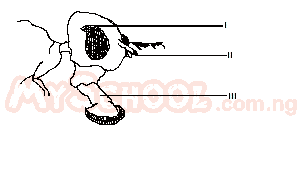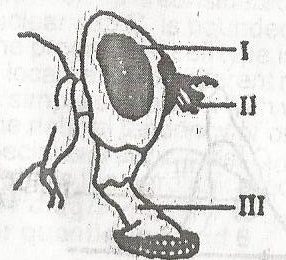Year :
1999
Title :
Biology
Exam :
JAMB Exam
Paper 1 | Objectives
1 - 10 of 50 Questions
| # | Question | Ans |
|---|---|---|
| 1. |
The organism that has a hydrostatic skeleton is A. Tilapia B. Hydra C. mosquito larva D. earthworm |
D |
| 2. |
The possession of scales, laying of eggs with shells and bony structure of the head are characteristics shared by A. birds and reptiles B. fishes and birds C. reptiles and fishes D. birds and molluscs Detailed Solution-Fishes don not lay eggs with shells- Hence; these are features common to Reptiles and Birds |
|
| 3. |
The group of Arthropods that has no antennae is the A. Crustacea B. Chilpoda C. Arachnida D. Diplopoda |
C |
| 4. |
The structure that is most commonly identified in all living cells under the light microscope is the A. mitochondrion B. chloroplast C. nucleus D. ribosome |
C |
| 5. |
Which of the following is an organ? A. Guard cell B. Liver C. Xylem bundle D. Blood |
B |
| 6. |
 The structure labelled II is used for A. tasting B. feeling C. biting D. sucking |
B |
| 7. |
 The structure labeled III represents the A. mandible B. palp C. proboscis D. labium Detailed SolutionTwo small, antenna-like feelers called maxillary palp allow the fly to taste its food.The end portion of the proboscis, called the labellum, terminates in a spongy mouth, where the fly slurps its food. |
|
| 8. |
The division of a body into two equal halves along a longitudinal plane is called A. bilateral symmetary B. transverse section C. radial symmetry D. longitudinal section |
A |
| 9. |
In which of the following organisms does each cell combine the function of nutrition, reproduction and growth? A. Rhizophus B. Dryopteris C. Brachymenium D. Spirogyra |
D |
| 10. |
They key event in the transition of the amphibians from water to land is the A. replacement of the gills with lungs B. possession of webbed limbs C. development of long hing limbs D. possession of tympanic membrane |
A |
| 1. |
The organism that has a hydrostatic skeleton is A. Tilapia B. Hydra C. mosquito larva D. earthworm |
D |
| 2. |
The possession of scales, laying of eggs with shells and bony structure of the head are characteristics shared by A. birds and reptiles B. fishes and birds C. reptiles and fishes D. birds and molluscs Detailed Solution-Fishes don not lay eggs with shells- Hence; these are features common to Reptiles and Birds |
|
| 3. |
The group of Arthropods that has no antennae is the A. Crustacea B. Chilpoda C. Arachnida D. Diplopoda |
C |
| 4. |
The structure that is most commonly identified in all living cells under the light microscope is the A. mitochondrion B. chloroplast C. nucleus D. ribosome |
C |
| 5. |
Which of the following is an organ? A. Guard cell B. Liver C. Xylem bundle D. Blood |
B |
| 6. |
 The structure labelled II is used for A. tasting B. feeling C. biting D. sucking |
B |
| 7. |
 The structure labeled III represents the A. mandible B. palp C. proboscis D. labium Detailed SolutionTwo small, antenna-like feelers called maxillary palp allow the fly to taste its food.The end portion of the proboscis, called the labellum, terminates in a spongy mouth, where the fly slurps its food. |
|
| 8. |
The division of a body into two equal halves along a longitudinal plane is called A. bilateral symmetary B. transverse section C. radial symmetry D. longitudinal section |
A |
| 9. |
In which of the following organisms does each cell combine the function of nutrition, reproduction and growth? A. Rhizophus B. Dryopteris C. Brachymenium D. Spirogyra |
D |
| 10. |
They key event in the transition of the amphibians from water to land is the A. replacement of the gills with lungs B. possession of webbed limbs C. development of long hing limbs D. possession of tympanic membrane |
A |